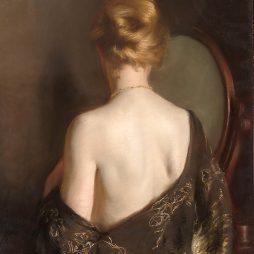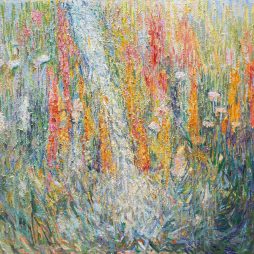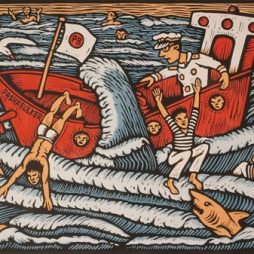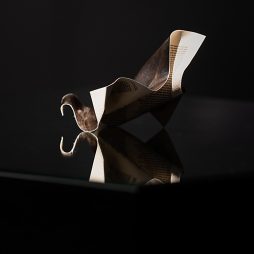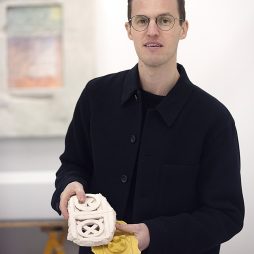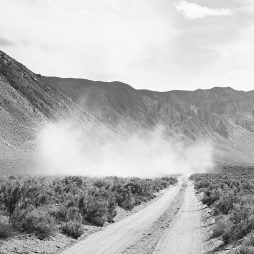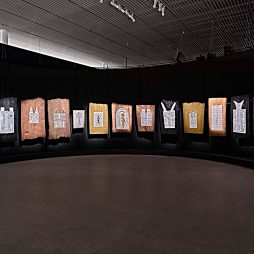Isaac Julien in Australia
For more than a decade, London-based Isaac Julien has had a regular exhibiting presence in Australia and New Zealand. A quadripartition of Australian exhitbitions will celebrate the artist this from spring 2021, until autumn 2022.
Isaac Julien confessed to Laura Barnett in a Guardian article in 2013 that he was a frustrated painter. Therefore, it’s unsurprising that his film and video works are so painterly, that his installations inhabit gallery spaces, and his picture-making within each frame is so considered and visually poetic. Like Francisco de Goya and Gustave Courbet before him, he constructs powerful images that document the pivotal events of his time. Beautiful to look at and carefully crafted, they retain their political and cultural integrity, providing an alternative to mainstream reportage of social justice issues.
In his early sixties, Julien lives and works in London. He was born and raised in London’s East End to parents from the Caribbean island-nation of St. Lucia. Julien adopted video as a medium while still a student at Central Saint Martins in London in the early 1980s. Using the school’s equipment, he made Who Killed Colin Roach in 1983. It is a germinal work that anticipates the form and content of later projects such as Lessons of the Hour, 2019, and Ten Thousand Waves, 2010, to be shown at the John Curtin Gallery in Perth early in 2022. In these works, he balances the formal beauty of filming with a razor-sharp critical interrogation that resonates emotionally to generate an empathetic response that speaks to our shared humanity.
In that first video work, Julien focused on the story of Colin Roach, a twenty-three-year-old Black man killed on the steps of Stoke Newington Police Station in 1982. The police claimed it was suicide, so Julien turned the lens on Roach’s family and the participants in the riots that erupted in the community. He dramatically shifted focus to investigate further and reveal the human consequences of their actions. As he explained to the Tate Gallery in 2015, “ . . . this took me back to the whole idea of the camera as a street weapon . . . I insisted my camera be engaged in politics.” The film retains its contemporaneity, not only because of its succinct style but sadly because of the continued instances of Black men, such as George Floyd, Freddie Gray, Trayvon Martin, Kendrec McDade, and so many more, being killed by law enforcement officers.
Julien’s engagement with politics, with “setting the record straight” and providing an alternative narrative to that presented by the dominant culture, has continued to shape his work. For example, his ten-screen installation Lessons of the Hour explores the life of freed slave Frederick Douglass, who fought against slavery and for women’s suffrage in the nineteenth century. Douglass was also a passionate advocate for photography, which links to Julien’s aesthetic interests and allows him to explore how content can be shaped by the medium delivering the message.
In this immersive work, Julien choreographs the audience’s movement through the story and the gallery. As the incidents surrounding Douglass’s life unfold on the various screens, we are drawn further into the gallery space. Rather than watching, we share Douglass’s experiences of confronting racism, speaking to large audiences, and advocating passionately for the abolition of slavery. “Equality is of no race, gender, colour, creed or nation,” Douglass proclaimed, and the currency of his message is not lost on a contemporary audience. His “Lessons of the Hour” speech from 1894 (which gives the film its name) is interspersed with footage of the 2015 Baltimore riots following the death of Freddie Gray. “The immediate future looks dark and troubled,” intones Douglass, and we all shudder and hang our heads low; maybe even shed a tear.
Julien is a master technician who works all aspects of his medium to generate the greatest emotional and intellectually resonant response from his audience. His early work as a dresser at the Royal Opera and for musicals such as Evita at the Prince Edward Theatre in London gave him direct contact with the power of integrated art forms that blend movement, sound, and vision. In Lessons of the Hour, the story of Douglass’s life plays out like a score as episodes move to the different screens in a narrative choreography. These elements are fused together by the medium of film making, made possible by photography. Douglass’s passionate advocacy for this new medium and its potential as a political tool to demolish stereotypes is grist to Julien’s creative mill. The re-creation of J.M. Ball’s nineteenth-century photographic studio for the filming was clearly a labour of love and the innovator in Douglass, who is credited with revolutionising portrait photography by suggesting a tight focus on the face and reducing the elaborate Victorian scenic backgrounds to plain white or black screens, gives Julien the opportunity to extrapolate on Douglass’s comment that, “Pictures are like songs, they should be left to make their own way into the world. All they can reasonably ask of us is that we place them on the wall and allow themselves to speak for themselves.” Of course, selection and careful editing can enhance their vocal range considerably, as Julien knows only too well. For both Ball and Douglass, the photograph put power back in the hands of Black people, who were able to manage and control their self-image rather than suffer at the hands of bigoted caricaturists. Julien takes this power as his birthright and pays homage to the men who bequeathed him that tool in this extraordinary project.
His video installation Ten Thousand Waves uses similar strategies to investigate an incident involving Chinese migrant workers in England in 2004. For Julien, choreography, and dance, are also metaphors for the movement and migration of peoples and in this work, shown as part of the 17th Biennale of Sydney in 2010, audiences are again drawn physically into the drama as they follow the story of the twenty-three cockle pickers who died in the Morecambe Bay Tragedy.
On nine screens, Julien juxtaposes and intercuts a recreation of a 1934 Chinese film titled The Goddess, with scenes from Fujian province in Southern China, the cockle pickers’ home, and footage of the rescue operations at Morecambe Bay. These sections are further interspersed with scenes of Mao-era and present-day China. As with Lessons of the Hour, the blending of then and now succinctly makes the point that constant vigilance is required if we are not to endlessly repeat the same mistakes. In this project, the overarching presence is another inspirational figure: in this case Mazu, the patron goddess of fishermen and seafarers. She floats through the landscape and hovers over sleeping fishermen. She calls out to those from the past and those dying at Morecombe Bay and to those living in modern-day China, (“O soul, come home!”).
Julien has previously said that “language is cool, valueless and lifeless,” yet he powerfully interjects Wang Ping’s poem Small Boats, 2010, with chilling effect.
“We know the [death] tolls . . . We know the methods: walk, swim fly, metal container, back of a lorry, ship’s hold. We know how they died: starved, raped, dehydrated, drowned, suffocated, homesick, heartsick, worked to death, working to death. We know we may end up in the same boat.”
This bricolage of images and ideas has become the artist’s “modus operandi.” He brings together different forms, themes, times, and places into a beautifully constructed and multi-faceted whole that has lasting impact. This approach is also evident in the single screen version of his 2007 work Western Union Small Boats, that examines similar themes of migration and disaster. However, in this instance, Julien focuses on trans-Mediterranean crossings to Europe. Acquired by the Art Gallery of New South Wales in 2018, this will be the first showing of Small Boats when installed as part of the exhibition Family: Visions of a Shared Humanity curated by Franklin Sirmans, the director of the Pérez Art Museum Miami.
In tandem with A Marvellous Entanglement, 2019, having its Australian premiere at the Samstag Museum of Art, and a solo exhibition at Roslyn Oxley9 Gallery, the opportunity to see so much of Isaac Julien’s work across the country constitutes a national celebration of this important artist’s significant contribution to our re-imagining of the world we share.













